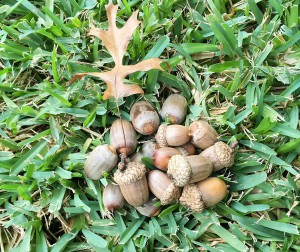 You rake and you bag acorns, and depending on the year, you will do it several times. This is the life of an oak tree owner in the fall. For another way to handle the acorn crop look to Mother Nature. Ya see critters love acorns. The fun-loving squirrel and whitetail deer are at the top of the list. The squirrels are everywhere but they’re not pulling their weight. However, watching a creature as majestic as a whitetail deer is inspiring. But the problem is, there’s just not a lot of deer this part of Collin County. Don’t fret just yet!
You rake and you bag acorns, and depending on the year, you will do it several times. This is the life of an oak tree owner in the fall. For another way to handle the acorn crop look to Mother Nature. Ya see critters love acorns. The fun-loving squirrel and whitetail deer are at the top of the list. The squirrels are everywhere but they’re not pulling their weight. However, watching a creature as majestic as a whitetail deer is inspiring. But the problem is, there’s just not a lot of deer this part of Collin County. Don’t fret just yet!
Have you ever eaten an acorn? I have eaten an acorn before and I will say, it tasted just awful. Now, this was a raw acorn that had just fallen from an unknown species of an oak tree in East Texas close to thirty years ago. My palate may have become enlightened, the acorns might have gone through some culinary type of evolutionary change, or I was doing it wrong. I have recently found out that the latter was correct. I have also realized that I have to be really hungry to eat raw acorns. Bottom line is that there is a push for human consumption of acorns going on.
There is nutritional value in acorns. But you have to know the proper way to handle them and prepare them. What we are trying to reduce is the “Tannins”. This commonly referred to as tannic acid. Wines that are dry have a higher tannic acid content than those that are sweet. Acorns in our part of the world have a high tannic acid level. Once the tannins have been reduced the meat of the acorn can be ground into flour and used like wheat or corn. I have never tried this but I think there may be acorn pancakes in my future. So I guess my question is how “green” do you want to be?





